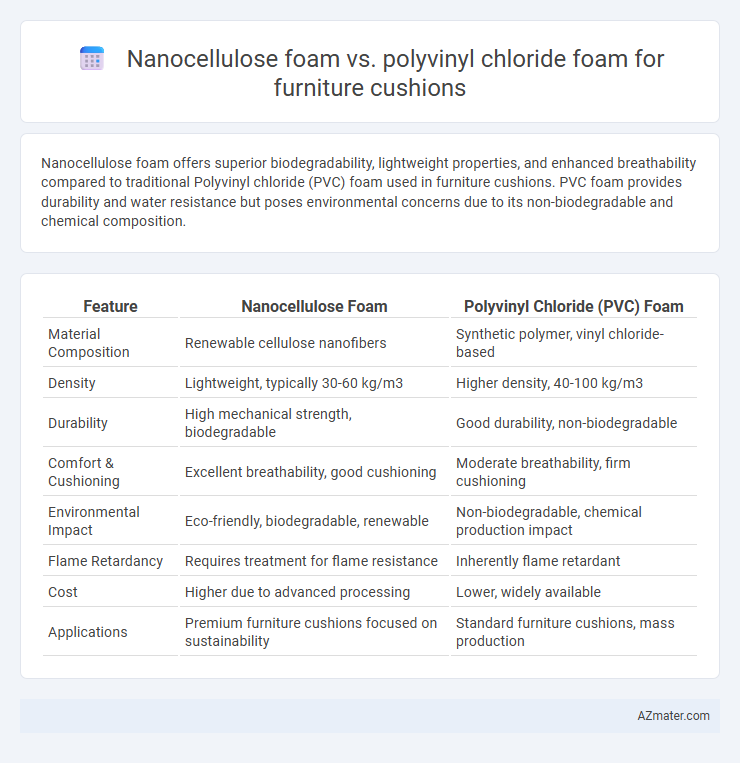Nanocellulose foam offers superior biodegradability, lightweight properties, and enhanced breathability compared to traditional Polyvinyl chloride (PVC) foam used in furniture cushions. PVC foam provides durability and water resistance but poses environmental concerns due to its non-biodegradable and chemical composition.
Table of Comparison
| Feature | Nanocellulose Foam | Polyvinyl Chloride (PVC) Foam |
|---|---|---|
| Material Composition | Renewable cellulose nanofibers | Synthetic polymer, vinyl chloride-based |
| Density | Lightweight, typically 30-60 kg/m3 | Higher density, 40-100 kg/m3 |
| Durability | High mechanical strength, biodegradable | Good durability, non-biodegradable |
| Comfort & Cushioning | Excellent breathability, good cushioning | Moderate breathability, firm cushioning |
| Environmental Impact | Eco-friendly, biodegradable, renewable | Non-biodegradable, chemical production impact |
| Flame Retardancy | Requires treatment for flame resistance | Inherently flame retardant |
| Cost | Higher due to advanced processing | Lower, widely available |
| Applications | Premium furniture cushions focused on sustainability | Standard furniture cushions, mass production |
Introduction to Nanocellulose and Polyvinyl Chloride Foams
Nanocellulose foam, derived from cellulose fibers, offers exceptional biodegradability, high strength-to-weight ratio, and excellent moisture-wicking properties, making it an innovative alternative in furniture cushioning. Polyvinyl chloride (PVC) foam, a synthetic polymer, provides durability, resistance to chemicals, and cushioning flexibility but poses environmental concerns due to its non-biodegradable nature. Comparing nanocellulose and PVC foams highlights a shift towards sustainable materials without compromising comfort and resilience in furniture applications.
Material Composition and Structure Comparison
Nanocellulose foam, derived from cellulose fibers, offers a biodegradable and renewable composition with a highly porous, nanoscale fibrillar network that provides excellent breathability and mechanical strength. Polyvinyl chloride (PVC) foam consists of synthetic polymers with a closed-cell structure, delivering superior water resistance and durability but limited biodegradability and lower environmental sustainability. The cellulose framework in nanocellulose foam results in lightweight, flexible cushioning with superior moisture regulation compared to the denser, chemically stabilized PVC foam commonly used in traditional furniture cushions.
Environmental Impact and Sustainability
Nanocellulose foam, derived from renewable biomass, offers significant environmental advantages over polyvinyl chloride (PVC) foam, which relies on fossil fuels and emits toxic chemicals during production and disposal. Nanocellulose foam is biodegradable and non-toxic, reducing landfill waste and contributing to a lower carbon footprint in furniture cushions. PVC foam's persistence in the environment and challenges in recycling present substantial sustainability concerns compared to the eco-friendly profile of nanocellulose alternatives.
Comfort and Ergonomics in Furniture Cushions
Nanocellulose foam offers superior breathability and pressure distribution compared to polyvinyl chloride (PVC) foam, enhancing comfort and reducing heat retention in furniture cushions. Its natural fiber structure provides excellent ergonomic support by conforming more effectively to body contours, promoting better posture and reducing fatigue. In contrast, PVC foam tends to be less adaptive and can trap heat, making it less ideal for prolonged seating comfort and ergonomic benefits.
Durability and Longevity Assessment
Nanocellulose foam offers superior durability and longevity compared to Polyvinyl chloride (PVC) foam due to its high tensile strength and excellent resistance to compression over time. PVC foam tends to degrade faster under prolonged stress and exposure to UV radiation, resulting in reduced cushioning performance and structural integrity. The biodegradable nature of nanocellulose foam also minimizes environmental impact while maintaining long-term resilience in furniture cushions.
Cost Analysis and Market Availability
Nanocellulose foam offers a sustainable alternative to polyvinyl chloride (PVC) foam with increasing market availability driven by growing demand for eco-friendly furniture cushions, though its cost remains higher due to advanced production methods. PVC foam remains widely available and cost-effective, benefiting from established manufacturing infrastructure and lower raw material expenses, making it the dominant choice in budget-conscious furniture markets. Cost analysis reveals nanocellulose foam's premium price is justified by biodegradability and superior mechanical properties, whereas PVC foam's affordability caters to mass production and large-scale distribution.
Manufacturing Processes and Scalability
Nanocellulose foam, derived from renewable cellulose fibers, undergoes a sustainable manufacturing process involving mechanical fibrillation and controlled drying, enabling precise density and porosity control ideal for customizable furniture cushions. Polyvinyl chloride (PVC) foam is produced through polymerization and chemical foaming that supports large-scale, cost-effective production with consistent material properties favored in mass-market furniture applications. While nanocellulose foam manufacturing is advancing in scalability due to eco-friendly demand, PVC foam currently dominates in industrial-scale output because of established processes and raw material availability.
Fire Resistance and Safety Features
Nanocellulose foam exhibits superior fire resistance compared to Polyvinyl chloride (PVC) foam due to its natural cellulose structure, which char rather than melt or emit toxic gases during combustion. Unlike PVC foam, which releases harmful chemicals such as hydrogen chloride when burned, nanocellulose foam ensures a safer indoor environment by minimizing toxic smoke and enhancing fire safety standards. Its biodegradability also offers an eco-friendly advantage, making it an ideal choice for furniture cushions prioritizing both occupant safety and environmental health.
Moisture Resistance and Maintenance
Nanocellulose foam offers superior moisture resistance compared to Polyvinyl chloride (PVC) foam, preventing mold and mildew growth in furniture cushions. Its hydrophobic properties reduce water absorption, leading to easier maintenance and longer-lasting durability. In contrast, PVC foam tends to absorb moisture, requiring more frequent cleaning and potential replacement due to degradation.
Future Trends and Innovations in Furniture Cushion Foams
Nanocellulose foam is emerging as a sustainable and lightweight alternative to polyvinyl chloride (PVC) foam for furniture cushions, driven by its superior biodegradability and enhanced mechanical properties. Innovations in nanocellulose processing techniques, such as hydrogel formation and freeze-drying, enable customization of foam density and resilience, positioning it as a key material for eco-friendly furniture design. Future trends emphasize integrating nanocellulose with bio-based polymers for improved flame retardancy and antibacterial functionality, surpassing the performance limitations of traditional PVC foams.

Infographic: Nanocellulose foam vs Polyvinyl chloride foam for Furniture Cushion
 azmater.com
azmater.com